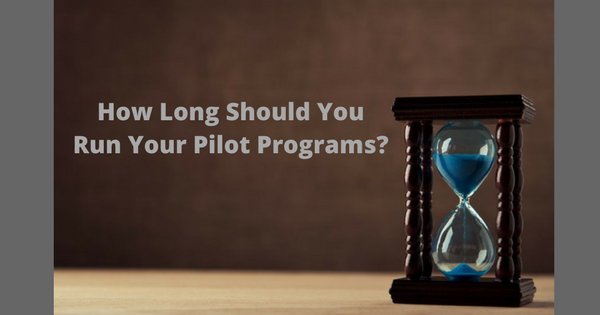When we talk with a retailer who is considering an Alert Tech pilot program, one of the questions that inevitably comes up is, “What is the recommended length of the program?”
Obviously, you want to wrap up the pilot program in a reasonable amount of time, and there needs to be an endpoint so that it’s clear when to make a decision on whether to move forward with a broader implementation. On the other hand, if you don’t give your pilot program enough time to run, how will you get data you can trust?
There’s no one-size-fits-all answer to the right length for a pilot, but there is a number that will work for your brand.
First Define Success
Before we even begin a pilot program, we need to define what success looks like. Besides sales, what metric means the most to your business? Is it foot traffic? Wait times? Service oriented metrics?
Often our clients will have some idea of which metrics they’d like to improve, or which matter most to their brand. But also, they’re usually not clear just how they stack up against industry benchmarks, or where there is the most room for improvement.
To know what’s reasonable to expect for your brand, we first need to know your starting point. For example, if your goal is to drive more traffic into your fitting rooms, and the industry average is 25% conversion from door traffic to the fitting room, where are you in relation to that? Are you already well above that benchmark? Or significantly below it?
We use the first phase of the pilot to get a baseline and compare your actual store data with industry standards. After we’ve determined your starting point, we can set realistic goals for your pilot.
Store metrics will of course vary weekly and seasonally, but one to two weeks will provide the data we need for a solid baseline.
Set Action Steps
 With clear goals, we now need to define exactly what to do to make those goals a reality for your business.
With clear goals, we now need to define exactly what to do to make those goals a reality for your business.
Every brand is different. We can help you set action steps that will provide forward progress toward the overarching goal of increasing store revenue.
For example, if we look at the goal of driving 25% of door traffic into the fitting rooms, we can assess what is happening on the sales floor that is causing low fitting room conversion, and train associates in behaviors that will increase those conversions.
The Minimum Viable Time for Reliable Results
The minimum viable time to see true results from a pilot is one quarter. There are several reasons for this.
Your team will need to be trained on the new system. We can’t expect them to be familiar with the new technology overnight. Sometimes, teams need a little extra push to get over the learning curve. It’s not that the technology isn’t easy to use, but it takes time for your team to adapt and develop the habit of using the system.
For example, in a recent pilot, we didn’t start to see a significant payoff until we matched our reporting cadence with the district manager’s cadence with the stores. As soon as each store started to see the results from their district manager, they saw an uptick in their usage and metrics. This helped make the pilot more fruitful.
Once your team has fully adopted the new technology, we start to see results that would match the outcome of a long term implementation. Although one quarter is the minimum viable time limit for a pilot, we often see even more improvement over two quarters.
Consider Seasonal Variation
When planning a pilot, you’ll want to consider not only the length of the pilot but the quarter in which we perform the pilot.
Obviously, sales in quarter one don’t compare to sales in quarter four. In a cyclical industry such as retail, testing over multiple quarters will give a more accurate representation of the performance of the project over time, and will allow for better projections overall.
Summary
To truly evaluate a pilot, you must give it enough time to succeed or fail in meeting the stated goals. To do this, you need enough time to define your goals, decide on action steps, train your team, and gather enough data to get a true representation of the performance of the system.
This takes a minimum of one quarter. If budget permits, the pilot will provide optimal data over two or more quarters.
